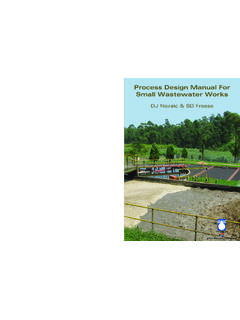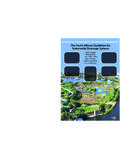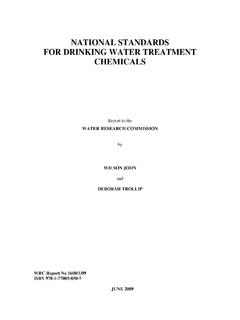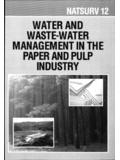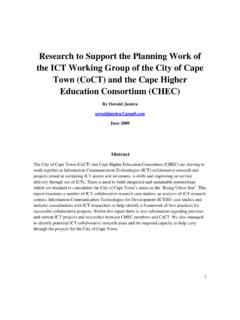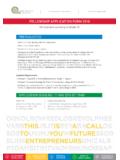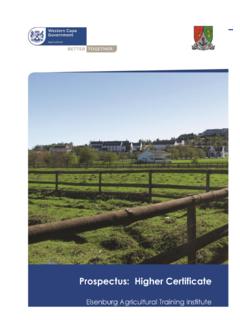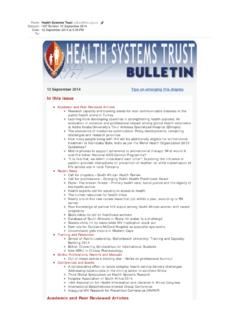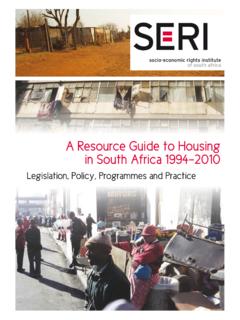Transcription of RESEARCH ON BERG RIVER WATER MANAGEMENT
1 RESEARCH ON berg RIVER WATER MANAGEMENT SUMMARY OF WATER QUALITY INFORMATION SYSTEM AND SOIL QUALITY STUDIES Editors : AHM G rgens and W P de Clercq Departments of Civil Engineering and Soil Science, university of stellenbosch WRC Report No : TT 252/05 October 2005 Obtainable from : WATER RESEARCH Commission Private Bag X03 Gezina 0031 The publication of this report emanates from a project entitled A WATER Quality Information System for Integrated WATER Resource MANAGEMENT : The Riviersonderend- berg RIVER System (WRC Project No. K5-951). ISBN No. 1-77005-367-0 Printed in the Republic of South Africa DISCLAIMER This report has been reviewed by the WATER RESEARCH Commission (WRC) and approved for publication. Approval does not signify that the contents necessarily reflect the views and policies of the WRC, nor does mention of trade names or commercial projects constitute endorsement or dti f WQIS for Integrated WATER Resources MANAGEMENT : The Riviersonderend- berg RIVER System i PREFACE BACKGROUND Impoundments and associated bulk WATER supply infrastructure are present in most South African RIVER systems.
2 Because of the disparate natural occurrence of rainfall and runoff, and its mismatch with WATER demand concentrations, many of these schemes have to incorporate inter-catchment transfers to meet demands in the face of inadequate local availability. Furthermore, WATER quality deterioration, because of human impacts through a wide range of land-uses and waste discharges, has for some time been recognised as a threat in South Africa, as it diminishes the utilisable part of the runoff in many catchments. These complexities increasingly offer challenges to WATER resource managers that require a response with integrative MANAGEMENT philosophies and innovative MANAGEMENT tools. In recognition of the aforementioned needs, Prof Andr G rgens of the Department of Civil Engineering of the university of stellenbosch , during 1997, engaged WATER resource managers in the Department of WATER Affairs and Forestry in discussions about an appropriate RESEARCH response to these MANAGEMENT challenges.
3 From these discussions a RESEARCH proposal to the WATER RESEARCH Commission (WRC) was born, whose aim would be to serve the philosophy of Integrated WATER Resource MANAGEMENT (IWRM), through the development of an integrated information system specifically for WATER quality here abbreviated to WQIS . To be useful to IWRM, this WQIS was to provide diagnostic and predictive utilities to serve technical planning and operational decision-making in a RIVER system, but, simultaneously, provide appropriate information to support WATER managers in communication with technical stakeholders. It was also recognised that the project would need identification of a prototype catchment for development of appropriate WQIS approaches and to provide a relevant database. Early candidate catchments for this purpose were the berg RIVER and Breede RIVER in the Western Cape and the inter-connected Fish-Sundays RIVER system in the Eastern Cape.
4 Simultaneous with the RESEARCH formulation process described above, the late Prof Hulme Moolman of the Department of Soil and WATER Science1 (DSWS) at the university of stellenbosch , started formulating a RESEARCH proposal to the WRC to investigate the causes of and quantification of salinisation of the berg RIVER , one of the prime WATER sources to meet growing demands in the Greater Cape Town and West Coast Region. Both the Department of WATER Affairs and Forestry and agricultural and industrial stakeholders had expressed concern about perceptions that Middle- to Lower- berg RIVER salt concentrations appeared to be on the increase. Unfortunately, Prof Moolman, who at the time was engaged in salinity-related RESEARCH in the neighbouring Breede RIVER catchment and who was the leading salinity-related researcher in South Africa, fell gravely ill before the RESEARCH proposal approval process was completed.
5 As a strategy to ensure that the RESEARCH process at the DSWS would continue regardless of the outcome of Prof Moolman s illness, the WRC requested Prof G rgens, who had done salinity-related RESEARCH in the past, to take over MANAGEMENT of both his own Department s RESEARCH proposal and that of the DSWS. The result was that the two separate proposal formulation processes were merged to form a single Terms of Reference and, ultimately, a single contract between the WRC and the university , with Prof G rgens as the Project Leader. It then also made sense to select the berg RIVER as the prototype for the WQIS development, partly because of the accent that the DSWS RESEARCH would put on salinisation processes, which is one the berg RIVER s most pressing issues, and partly because the berg contains all the general WATER resource MANAGEMENT challenges and complexities referred to earlier2.
6 1 Now called the Department of Soil Science. 2 The combined impoundments of the Riviersonderend- berg RIVER (RSE-BR) system currently contribute more than 80% of the total annual WATER yield of 450 million m3 available to the Greater Cape Town and West Coast Region. The current RSE-BR system comprises Theewaterskloof Dam on the RSE RIVER , linked by tunnels to the berg and Eerste RIVER catchments, as well as Wemmershoek and Vo lvlei Dams (both of which are off the berg RIVER main-stem). Sustained growth in the WATER requirements of the Region necessitates expansion of the RSE-BR system in the near future. The following berg RIVER schemes have been under investigation for implementation: Skuifraam Dam in the Upper- berg , Skuifraam Supplement Scheme downstream of Franschhoek and Middle- berg Diversion Scheme to Vo lvlei Dam.
7 Apart from supplying the bulk needs of the Region, these schemes would also serve the Government s rural development strategy in that they will support upliftment of a number of disadvantaged communities in the berg catchment and will make possible development of irrigation schemes for emergent farmers from these communities. Additionally, irrigation extensions by currently established farmers will be made possible. However, the implementation of these schemes would remove an additional 20% of fresh WATER from the berg RIVER main-stem and will lead to a more regulated RIVER system between Skuifraam and the Lower berg . The likelihood of all these developments has sparked serious concerns relating to future WATER quality fitness-for-use and maintenance of ecological integrity. PREFACE WQIS for Integrated WATER Resources MANAGEMENT : The Riviersonderend- berg RIVER System ii PROJECT AIMS The original aims of the project as specified in the WRC contract are as follows: i) To develop WATER Quality Information Systems to support both integrated MANAGEMENT of a WATER resources system, and to support communication about WATER quality MANAGEMENT with stakeholders and communities in the catchments of that system.
8 Ii) To develop an understanding of the primary WATER quality responses, and their causes, of the Riviersonderend- berg RIVER (RSE-BR) System, which would serve as a case study for the WATER Quality Information System implementation. iii) To evaluate the potential for operation of the future RSE-BR System to meet recently developed salinity guidelines for irrigation. As the project planning unfolded, it became clear to the Steering Committee that the aims needed adjustment for two sets of reasons: On the one hand, they were too broad for the available budget and time-frame. On the other hand, parallel development of suitable approaches to community participation in IWRM, as part of DWAF s initiatives to implement the National WATER Act, were forcing a change in the focus of the project. The Steering Committee, therefore, agreed that most of the RESEARCH focus would fall on Aims (i) and (ii), and that (iii) should be seen as a long-term objective of salinity-based RESEARCH in the berg RIVER catchment.
9 Furthermore, the Steering Committee agreed that the WQIS would primarily be developed as a technical information tool aimed at supporting WATER resource managers and stakeholders on the technical domain, and that communication support for community participation in consultative WATER MANAGEMENT processes would fall outside the ambit of the current contract. TWO RESEARCH THEMES, TWO RESEARCH TEAMS The background described earlier, as well as the stated objectives, imply that two related, but essentially different, RESEARCH themes underlie this project: Theme One: Development and/or application of decision support software for general WATER quality MANAGEMENT in a RIVER system with diverse components and human impacts. Theme Two: WATER quality-related RESEARCH in the form of field-scale process studies and large-scale soils data interpretation, with a strong focus on salinisation processes.
10 It follows that, when the project was resourced at its initiation in July 1998, the two RESEARCH Themes, and the involvement of two different university Departments, would lead to the establishment of two separate RESEARCH Teams. The Theme One RESEARCH ( WATER quality MANAGEMENT decision support software) was undertaken by the Department of Civil Engineering and comprised the following researchers: - Prof AHM G rgens Project Leader - N Nitsche Hydrodynamic RIVER Flow and WATER Quality Modeller (full-time) - W Kamish Reservoir Modeller (part-time) - J Tukker WATER Quality Information System Software Developer (full-time) - MP Matji Support Hydrologist (part-time). The Theme Two RESEARCH (field-scale-processes and large-scale mapping) was undertaken by the Department of Soil Science and comprised the following researchers: - WP de Clercq Senior Researcher (full-time) - Prof MV Fey Specialist Advisor (part-time) - Dr F Ellis Specialist Soil Scientist (part-time) - H Engelbrecht Junior Researcher (full-time) - K Latief Laboratory Assistant (full-time) - K Davidse Laboratory Assistant (part-time) - P Basson Technikon Internship (full-time for one year) - M van Meirvenne Visiting Researcher (part-time) - G de Smet Visiting Researcher (part-time) PREFACE WQIS for Integrated WATER Resources MANAGEMENT : The Riviersonderend- berg RIVER System iii Mr Willem de Clercq, appointed at the Project initiation as full-time Senior Researcher, took care of the Department of Soil Science component of the RESEARCH .

